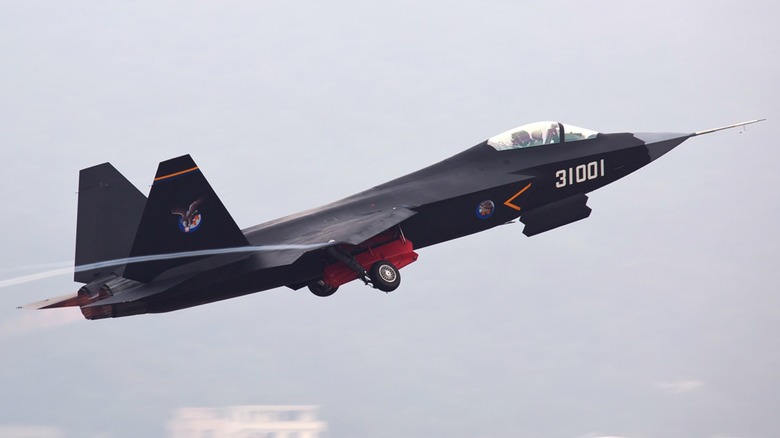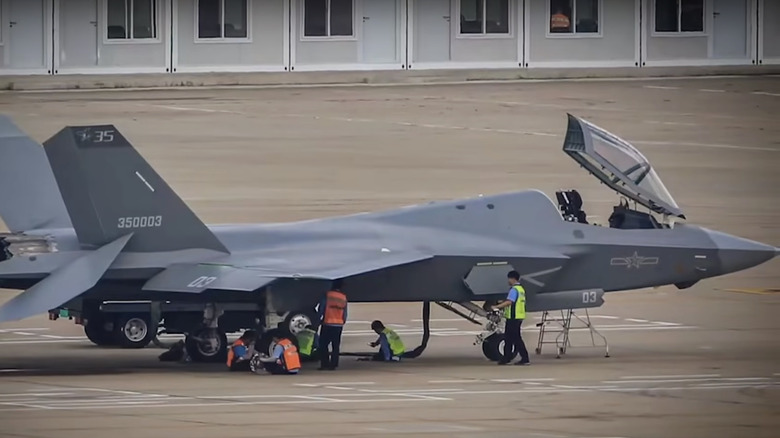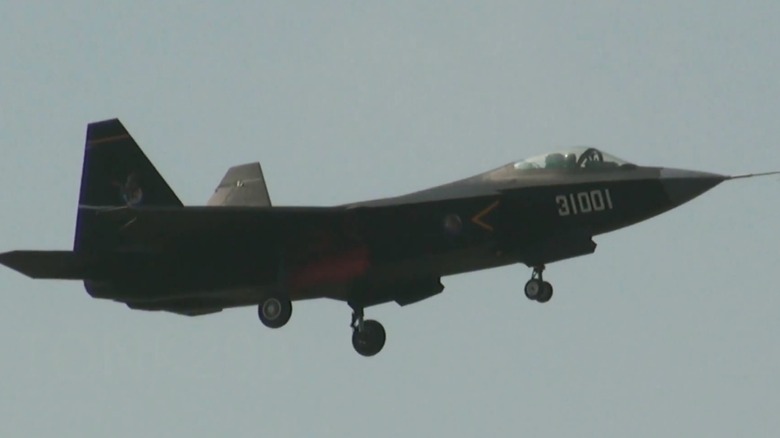Here's What We Know About China's Fifth-Generation Fighter Jet, The Shenyang FC-31
The People's Republic of China has a nasty habit of ripping off weapon designs from the West, and it appears the PRC is back at it with its latest fifth-generation fighter aircraft. The Shenyang FC-31 Gyrfalcon is a prototype twinjet multirole aircraft that strikingly resembles the U.S. F-22, though it also has aspects of the F-35's exterior design.
Despite the clear inspiration for the aircraft, there's not much the West knows about it. Supposedly, only two are known to exist, and the South China Morning Post reported that the FC-31's first flight occurred way back on October 31, 2012. Yet arguably the most interesting part about the FC-31 is its origin story. The aircraft is being developed privately by Shenyang Aircraft Corporation for potential export. This was done after the People's Liberation Army Air Force (PLA) Air Force officially endorsed the Chengdu Aerospace Corporation's J-20, which is in full production and use by the PLA.
Both fighters are stealth capable, making China and the United States the only nations with two such aircraft. (The U.S. flies the F-22 and F-35.) The FC-31 will be carrier-based, which would significantly extend the PRC's reach with modern stealth fighter jet aircraft. It's unclear if the PRC will roll out large numbers of these aircraft in the future, but for now, they are producing at least some.
[Featured image by Danny Yu via Wikimedia Commons | Cropped and scaled | CC BY-SA 4.0]
The Shenyang FC-31's capabilities
Because the FC-31 is still under development, and the nation that's building it is the PRC, there's not much known about its capabilities. When it was revealed in 2012, only a model was shown to the public. Two years later, the aircraft was featured at the Zhuhai Airshow. What is known is that the FC-31 is slightly smaller than the J-20 and features an internal weapons bay to carry its missiles.
Externally, the FC-31 has six hardpoints capable of carrying a variety of weapons. Altogether, the aircraft will likely carry up to 17,600 lbs. of munitions, including various bombs and missiles. Regarding the engine, the FC-31 is outfitted with twin Klimov RD-93 turbofans, which also power the Russian MiG-29 fighter jet. This will give the aircraft a combat radius of approximately 750 miles with a takeoff weight of 56,000 lbs. It will likely fly up to Mach 1.8 (roughly 1,370 mph) with a maximum non-combat range of 2,486 miles.
The FC-31 is also coated with a stealth covering, making it difficult to spot with radar and a competitor to its counterpart in the U.S. If and when it's added to the PLA Navy's inventory, the FC-31 will be able to perform a variety of missions. These include air defense, air superiority, air policing, reconnaissance, nuclear deterrence, close air support, anti-ship attacks, air-to-ground precision strikes, and buddy-buddy air refueling.
[Featured image by David Wang via Wikimedia Commons | Cropped and scaled | Fair Use]
At least one country already wants to buy J-31 aircraft
As the Shenyang Aircraft Corporation continues to refine the design, the FC-31 has and will receive several alterations. The plan is to outfit the aircraft with the Guizhou WS-19 turbofan engine, which would make its engine comparable to the J-20. Western analysts consider the FC-31 to be a match for existing fourth-generation fighters, including the F-15, F-16, and F/A-18, but it wouldn't necessarily contest fifth-generation fighters.
That could change if the PRC produces enough aircraft and outfits them with comparable radars, sensors, and weapons, though. With enough time, a host of well-trained pilots, and the resources to maintain them, the FC-31 could become one of the world's premiere fighter aircraft, but only time will tell how the PRC develops the program.
Meanwhile, several nations have shown an interest in procuring the FC-31 when it hits the market. In January 2023, Pakistan's Chief of Army Staff General Asim Munir showed interest in acquiring foreign-made aircraft, including the legendary C-130 and the JC-31 stealth fighter. In addition to exports, further development of the program may see the JC-31 make its way to one of the nation's three aircraft carriers.
[Featured image by 天剣2 via Wikimedia Commons | Cropped and scaled | CC BY-SA 4.0]


